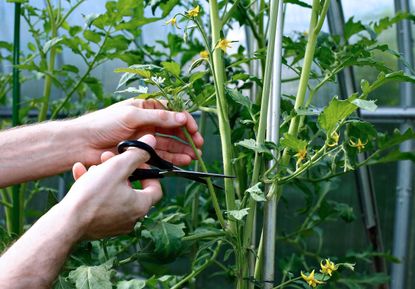Pruning Tomato Plants – Tips On Removing Tomato Plant Leaves


As you read and learn about a specific plant’s pruning needs and preferences, you may develop some pruning anxiety. This is especially true of pruning shrubs, which have all sorts of strict rules like, “prune immediately after flowering”, “only cut back during dormancy”, or “cut the flower stem above an outward facing bud or above a five-leaflet”. With such specific pruning rules, you may feel like you need to set up a diagram next to a shrub to prune it properly.
Not all plants are fussy about pruning, though. Most annual and perennial plants are much more laid back when it comes to pruning habits. Forget to deadhead them? They’ll forgive you. Cut it back too short? No worries, it’ll fill back out in no time. One of my favorite forgiving plants to care for are tomato plants.

Can I Cut Tomato Leaves?
Yes, you can. Many years ago, before I really knew anything at all about plants or gardening, I bought a small starter Sweet 100 tomato plant. I planted it in a large pot on a sunny balcony and in just a few weeks it sprawled all over the balcony railings, covered with fruit blossoms. Then one night a particularly nasty storm blew it off the balcony, ripping many of its stems off, battering and bending what remained. I was heartbroken and figured that was the end of my tomato plant. Still, I placed it in a safer spot and cut off all the broken and damaged stems.
After I removed all the damage, it was as small as it had been when I purchased it. I didn't have much hope that I would get any tomatoes from it, but every evening I found myself sitting next to it, enjoying the summer breeze and carelessly picking at any suspicious looking leaf on the plant. The way it responded to my pruning reminded me of the mythical hydra, sprouting new stems, leaves and flowers wherever I snipped and pinched.
Your tomato plant won't really instantly grow three new stems in the place of every stem you cut, but it will reward your pruning efforts with a bounty of delicious fruit. Regularly pruning tomato plants will help the plant produce more fruit. Plants need foliage to create energy from photosynthesis, but the growth and development of foliage uses up a lot of the plant’s energy that could be used for fruit production. It is possible to get overzealous and wind up with an over pruned tomato plant, but removing dead, diseased, or just unnecessary leaves and stems from tomato plants increases the fruit.
Cutting Leaves on Tomatoes
When it comes to cutting back tomato plants, there are some things you need to know. Tomato plants fall in to two categories: determinate or indeterminate.
Pruning Determinate Tomatoes
Determinate tomato plants are shrub-like. They grow to a certain height, then stop growing up and instead fill out and grow bushier. Determinate tomato plants also go to flower and fruit all at once. Patio, Roma, and Celebrity are a few popular varieties of determinate tomato plants. Because they fruit in a shorter time span and grow as more compact plants, determinate tomato plants need less pruning.
Gardening tips, videos, info and more delivered right to your inbox!
Sign up for the Gardening Know How newsletter today and receive a free download of our most popular eBook "How to Grow Delicious Tomatoes."
When you first plant a determinate tomato, you should prune off any flower sets that form before the plant is 18-24 inches (45.5 to 61 cm.) tall. This will redirect the plant's energy from flower formation to developing strong roots.
As the plant grows, prune out any crossing, crowded, damaged, or diseased stems and foliage to keep the plant open, airy, and free of pest and disease. Removing tomato plant leaves that grow just beneath the flower sets will send more energy to fruit formation.
Pruning Indeterminate Tomatoes
Indeterminate tomato plants are more like wild vines. These grow as long as they can go and continually bear new fruit sets. You can save space in the garden and focus on fruit production by growing indeterminate tomato plants vertically up poles, arbors, trellises, fences, or as an espalier. They can be trained and trimmed easily to grow as single stemmed, heavy fruit bearing plants by removing excess tomato plant leaves and sucker stems that form along the main stem.
Many heirloom tomatoes, cherry tomatoes, and Better Boy tomatoes are popular varieties of indeterminate tomato plants. In late summer, they can be top pruned to redirect the plant’s energy into ripening its last fruits.
When pruning tomato plants, or any plants, focus first on removing foliage, fruits, or stems that show any sign of disease or pests. Then sanitize your tools and wash your hands to prevent the spread of any pests or disease that may have been present.
-
 Urban Beekeeping Guide: Top Tips For Raising Bees In The City
Urban Beekeeping Guide: Top Tips For Raising Bees In The CityUrban beekeeping can be a rewarding and appreciated pastime, but first be sure it’s legal in your city and learn the ropes of beekeeping.
By Mary Ellen Ellis
-
 2024 Plant Of The Year: Why Experts Say Philodendron Is The “It” Plant Of The Year
2024 Plant Of The Year: Why Experts Say Philodendron Is The “It” Plant Of The YearWe aren’t surprised that philodendron was designated the plant of the year. Versatile, easy-care and lovely, it’s the houseplant of the year 2024!
By Bonnie L. Grant